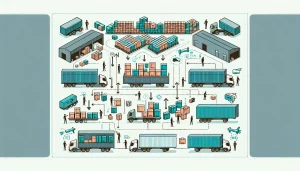The Electronic Logging Device (ELD) landscape is changing faster than a Tesla off the starting line, and what you don’t know could be costing you. We’re exploring the uncharted concerns hidden under the hood of ELD technology, something we’ve come to recognize not just as a necessity but as a powerful tool in the transport and logistics industry.
Imagine, over 3.5 million truck drivers in the U.S. alone, each generating a stream of data every second they’re on the road. That’s like creating three Great Pyramids of Giza worth of data daily!
But what exactly is an electronic logging device? More importantly, how can understanding it better equip you to navigate this digital-swamped highway? Buckle up as we break down the ins and outs of ELDs, illuminating the blind spots you didn’t even know you had. Discover how integrating ELD technology with hauling backloads can streamline your operations, turning obligatory journeys into profitable opportunities by minimizing wasted trips and enhancing overall efficiency.

Earn $1,200+/week delivering for local businesses
Driver benefits:
- Steady local business routes
- Weekly pay + tips
- Dedicated support team
- Flexible scheduling
Understanding ELD: The Unseen Powerhouse in Fleet Management
What is an Electronic Logging Device (ELD)?
An Electronic Logging Device, commonly known as an ELD, is a digital log book that effectively tracks a driver’s Record of Duty Status (RODS). ELDs replace traditional paper logs, reducing errors and enhancing record accuracy. They offer a significant leap towards business efficiency, ensuring drive time compliance and providing greater insight into fleet operations. Discover the essentials about Electronic Logging Devices – their purpose, functionality, and the pivotal role they play in modernizing fleet management and compliance.
The ELD system was implemented to improve driver safety, ensure adherence to hours-of-service (HOS) regulations, and streamline operations. This digital advancement assists companies in maintaining integrity and precise record-keeping while paving the way for a safer, more reliable trucking industry.
Trucking Industry Market Share Forecast:
The Truck segment in the electronic logging device market is estimated to gain the largest revenue share of about 40% in 2036.
The adoption of electronic logging devices has been monumental. It changed the landscape of fleet management and led to significant improvements in on-road safety and operational efficiency. The ELD mandate applies to most commercial motor vehicles and commercial motor vehicle drivers and requires the use of an ELD to automatically record driving time and duty status.
Global Electronic Logging Devices Market Size:
The global ELDs market size was valued at USD 14.39 billion in 2023.
How does an ELD work?
ELDs are powerful pieces of technology. They synchronize with a vehicle’s engine to monitor its status accurately. When the engine is running, the ELD tracks activity, including driving hours, idle time, and engine events, providing a comprehensive view of vehicle usage. The ELD device hardware is installed directly into the vehicle’s diagnostic port, which is usually located under the dashboard. With the help of a board support package, the device collects data from the engine control module (ECM) and automatically records driving activity.
This precision enables companies to plan better, giving them reliable data on driving hours, fuel consumption, and potential maintenance issues. The data is then transferred to a secure server where it can be accessed by fleet managers and compliance managers, ensuring regulatory compliance and promoting efficient fleet management practices.
ELDs offer real-time access to data, providing valuable information for proactive vehicle maintenance, HOS compliance, and driver safety. By shedding light on various aspects of fleet operations and driver behavior, ELDs provide essential insights that allow companies to optimize their operations, boosting productivity and profitability.
The role of ELD in fleet management
The importance of accurate data in fleet management cannot be overstated. ELDs play a pivotal role in collecting and analyzing this data. ELDs streamline operations, ensuring compliance, monitoring performance, and reducing administrative tasks.
By tracking on-duty and off-duty hours accurately, ELDs ensure adherence to HOS regulations, protecting both drivers and companies from potential violations. ELD data is used to analyze driver behavior, track vehicle performance, and schedule preventive maintenance, all critical elements in effective fleet management.
Moreover, ELDs enable efficient route planning. By analyzing historical data, managers can determine the best routes and schedules, reducing fuel costs and maximizing productivity. ELDs also provide GPS location data, which can be used to optimize routing and reduce driving time.
ELDs simplify compliance, reduce errors, and provide access to real-time data, enabling fleet and compliance managers to make informed decisions. The collected data helps fleet managers monitor vehicle data such as gross vehicle weight, engine hours, and fuel consumption. ELD devices also provide driver data, including driving hours, duty status logs, and driver vehicle inspection reports. Discover the intricacies of cargo arrangement strategies by understanding the role of ELDs in enhancing load efficiency and regulatory compliance.
In the ever-evolving world of business technology, the electronic logging device stands as a silent powerhouse instrumental to efficient fleet management operations. The near future for ELDs promises further innovation and enhancement in capacity, offering greater opportunities for efficiency across the fleet management industry.
Forecasted Market Size:
The ELD market is projected to reach USD 18.62 billion by 2032.
ELD Compliance: Ensuring Your Fleet Meets the Standards
What You Need to Know About the ELD Mandate
The ELD mandate, established by the Federal Motor Carrier Safety Administration (FMCSA), is no jargon; rather, it is a crucial factor impacting your business. The ELD rule requires most commercial drivers who are required to maintain hours of service (HOS) logs to use an electronic logging device (ELD) to record driver hours. Understanding and complying with the ELD mandate enhances the custody chain of your fleet’s operational data, ensuring safety and efficiency in your business operations.
Estimated Number of Drivers Affected:
The ELD mandate covers an estimated 3 million drivers per year.
Compliance with the ELD rule is mandatory for interstate commercial motor vehicles and commercial drivers. ELD compliance ensures accurate hours of service (HOS) recording, simplifies compliance and reduces errors. The collected data can be used to analyze driver behavior, improve driver compliance, and enhance safety.
Estimated Lives Saved:
The ELD mandate is expected to save 26 lives and prevent 562 injuries on average per year.
Ensuring ELD Compliance
To ensure ELD compliance, motor carriers need to choose a reliable ELD provider. The provider must have an ELD solution that meets the requirements of the ELD regulations. The provider should also offer driver training and support to ensure that drivers understand how to use the ELD device.
ELD performance is critical to ensure compliance with the hours of service (HOS) rules. The ELD provider should offer a device that automatically records driving time, monitors driver behavior, and provides real-time access to data. The provider should also offer a fleet management software that enables fleet managers to access the collected data and monitor driver compliance.
Cost of ELDs with Telematics:
The typical ELD with telematics costs $419 per year, or approximately $35 per month.
ELD compliance is essential to avoid penalties and fines. Non-compliance with the ELD mandate can lead to significant penalties, affecting the motor carrier’s reputation and bottom line. By ensuring ELD compliance, motor carriers can improve driver safety, reduce administrative tasks, and enhance operational efficiency.
Cost of ELDs without Telematics:
ELDs that use Bluetooth or USB 2.0 to transfer data are significantly cheaper, with an average price point of $166.
Choosing the Correct ELDs
Choosing the correct ELD is the first step – one that fits your fleet size, and the types of vehicles you operate, and complies with all FMCSA requirements – an ELD that’s not just a digital clock.
Implementing the Device in Your Operations
Implementation is where the rubber meets the road. This involves training drivers and operational staff on device use, developing policies around ELD use, and integrating the ELD data into your operational workflow.
Ongoing Compliance
ELD compliance isn’t a one-time event. It’s an ongoing process. It requires routine audits of ELD data, addressing any inconsistencies, and staying abreast with any mandate updates.
The Consequences of Non-Compliance
Avoiding compliance can provoke a harsh wake-up call. Non-compliance can lead to numerous penalties, from fines for the company to the driver being placed out of service, which could potentially snarl your operations and squeeze your profits.
Understanding these potential consequences underscores the importance of implementing ELDs effectively in your fleet operations.
Remember, the aim is not just compliance but leveraging ELDs to enhance the efficiency and productivity of your fleet.
Number of Devices Removed from List:
FMCSA removed 5 devices from the list of registered ELDs due to non-compliance.
The Benefits of ELD: More Than Just Compliance
Just as we traverse the terrain of ELD compliance, it’s essential to highlight not just the regulatory side of things but the benefits that are woven into the very fabric of ELD implementation.
Online Shopping Boosts Electronic Logging Device Market Growth:
The growing online consumer base is boosting the electronic logging device market, with an estimated 3 billion people estşmated to order food online by 2027.
Improving Fleet Efficiency with ELD
Pivoting your operations to revolve around Electronic Logging Devices has the potential to significantly streamline fleet management. By novel data-driven insights, it harnesses the raw potential of real-time tracking, streamlined communication, and proactive maintenance scheduling. Leverage the efficiency of backhaul freight opportunities to optimize your logistics even further, tapping into cost reductions and sustainability benefits for your operation.
ELD-Driven Proactive Maintenance
Preemptive maintenance is another feature that ELDs bring to the table. Since vehicles are the heart and soul of any fleet, keeping them operationally sound is key. ELDs closely monitor the health of each vehicle, flagging any mechanical issues that might be lurking beneath the surface. Consequently, minor problems are nipped in the bud before they manifest as full-blown breakdowns, thereby ensuring maximum vehicle uptime.
Embedded ELD Market Dominance in Developed Regions:
The embedded segment of the electronic logging device market is expected to lead, driven by the adoption of digital logging machines in developed regions like North America and Europe.
Enhancing Driver Safety through ELD
Driver safety is an asset that’s priceless. ELDs effectively curtail tired driving, a significant contributor to road mishaps, by steadfastly monitoring Hours of Service (HOS). This not only ensures your driver’s well-being but also safeguards other road users from potential hazards.
ELDs also come packed with additional safety features like real-time vehicle diagnostics and alerts for erratic driving behaviors like harsh braking or speeding. This, invariably, encourages drivers to adopt safer habits while simultaneously ensuring fleet managers have their fingers on the pulse of their fleet’s on-road performance.
The Human Element of Safety
While technology plays its role, let’s not forget the human aspect of driver safety. The transparent record-keeping capabilities of ELDs encourage drivers to maintain their compliance with HOS rules. The end result? A healthier work-life balance for drivers and less fatigue-related accidents.
Cost Savings and ROI From ELD Implementation
As fleet managers’ aim is not only to ensure a smooth operation but also to boost profitability, the potential financial implications tied to implementing ELDs cannot be ignored. Though the initial cost of adoption might seem substantial, the long-term financial advantages far outweigh these early investment costs.
ELD Device Cost:
The cost of ELD devices varies, but they are generally priced between $100 and $1000.
Direct savings stem from decreased fuel usage, lower administrative costs, and minimized upkeep costs due to preventative maintenance. Furthermore, indirect savings can be realized through lower crash rates and reduced insurance premiums.
The Long Game: ROI with ELDs
The ROI of ELDs sums up to more than just immediate monetary savings. As you embrace ELD, improved compliance records and an elevated safety profile can work wonders in shaping positive business perceptions. This not only nurtures current business relationships but also beckons new opportunities. Simply put, the ROI tied to ELDs stretches beyond numerical values, painting a comprehensive picture of long-term business sustainability.
As we move forward in this ELD journey, it’s clear that the merits are far more than just staying ahead of the law. The true beauty lies in enhanced efficiency, improved safety, substantive cost savings, and an undeniable return on investment. Such a compelling set of benefits only underscores the vital role ELDs play in contemporary fleet operations.
Navigating ELD Regulations: What You Need to Know
From identifying the benefits of ELDs, we now delve into the intricate world of ELD regulations. This section will serve as your compass, guiding you through regulatory mazes and updating you on timely changes.
Key ELD Regulations and Requirements
The Electronic Logging Devices mandate was published by the FMCSA in December 2015 to improve road safety. Let’s cut through the complexity and bring the mandate’s crucial aspects into sharp focus. Interestingly, expert insights suggest that under certain conditions, allowing trucks to idle could align with efficient fleet management practices, offering nuanced benefits contrary to popular belief.
The ELD Mandate – An Overview
The ELD mandate primarily entails that drivers who are required to maintain Record of Duty Status (RODS) must switch to ELDs from traditional paper logs. It standardizes the process of recording driving time, reducing potential errors and discrepancies. Interested in the ELD mandate’s impact on trucking efficiency? Discover how adherence to the ELD mandate revolutionizes fleet management and intersects with smooth pallet delivery operations.
Public utility services, short-haul operations, and drivers who operate under timecard exceptions are typically exempted from this mandate.
Specific Requirements
For an ELD to be compliant, it must meet certain requirements defined by the FMCSA. These include recording engine power status and vehicle motion status, and identifying malfunctions and data diagnostic events, among other details.
Data Security and Integration Concerns Limit ELD Market Growth:
Concerns about data security, privacy, and integration complexities restrain ELD market growth to some extent.
Recent Changes in ELD Regulations
Regulations aren’t static; they evolve over time to adapt to technological advancements and industry needs. Let’s explore recent changes in ELD rules.
Agricultural Commodity Carriers
There’s an extension to the existing hours of service (HOS) exemption for agricultural commodity carriers. Previously, these carriers were exempt from HOS rules within a 150-air-mile radius of their source during planting and harvesting seasons. Now, the exemption applies at the destination point, too.
How to Stay Updated on ELD Regulations
Keeping pace with regulatory changes can feel like trying to hit a moving target. Fortunately, plenty of reliable sources can help you stay current.
Official Sources
FMCSA’s website is the perfect starting point for obtaining official updates related to ELDs. Additionally, various industry bodies also issue updates related to ELD regulations and guidelines.
ELD Providers
Good ELD providers don’t just sell devices; they serve as valuable partners, offering updates and training on new regulatory changes.
Navigating ELD regulations requires you to stay attentive to the changing landscape. Armed with the right knowledge and tools, you can convert compliance challenges into opportunities for efficiency and growth.
Choosing an ELD: Factors to Consider
Understanding the Different Types of ELDs
To select an Electronic Logging Device (ELD) that best fits your business needs, the first step is getting acquainted with the different types available. ELDs range from models that deeply integrate with a truck’s technology, to portable ones that give users mobility and flexibility. There are standalone ELDs ideal for businesses with a single fleet type and systems that combine various technologies suitable for diversified fleet types. Understanding these differences can help companies choose an ELD that aligns perfectly with their operations.
Key Features to Look for in an ELD
After understanding different types of ELDs, the next step is identifying the key features that can boost your fleet operations. These may include GPS tracking, log auditing, IFTA reporting, engine diagnostics, communication tools, and more. Close scrutiny of these features and how they can improve your business operations is crucial for an educated decision.
Cost Considerations when Choosing an ELD
Purchasing an ELD doesn’t have to spar with your budget. It’s not just about the upfront costs – consider potential savings from increased efficiency, reduced fines, and lower maintenance costs that your chosen ELD can provide. Balancing initial costs, recurring payments, and potential returns on investment is essential.
Reviews and Recommendations for ELDs
Once you are well-versed with the types, features, and costs of different ELDs, it’s time to delve into their reviews and recommendations. These provide an additional layer of validation from those who have hands-on experience, thus giving a realistic insight into how the ELD operates in real-world scenarios.
By considering these factors, you set the stage for an informed decision on the ideal ELD selection that will effectively serve your business needs and be a valuable asset for your operations.
Wrapping Up On The ELD Story
Electronic Logging Devices (ELDs) revolutionize fleet management by improving safety, efficiency, and compliance. Their technology streamlines data recording, provides real-time tracking, and simplifies HOS management. Understanding the role of the middle mile in logistics can enhance the effectiveness of ELDs in monitoring and optimizing fleet performance.
Indeed, a critical tool in navigating the labyrinth of transportation logistics.
Now, the baton is in your hands. Empower your fleet with ELDs, synchronize your operations, and stay a step ahead. Implement ELDs and pave the way for a safer, more efficient future.
Here’s a thought – how do you envision ELDs shaping your fleet management rituals?
So, charge up. Embrace the ELD revolution, drive towards a safer, efficient and compliant tomorrow. Because progress waits for no one.






























